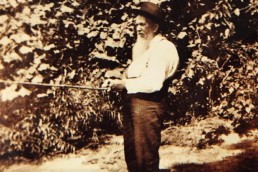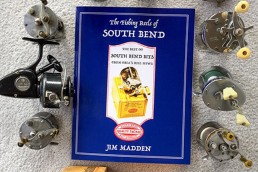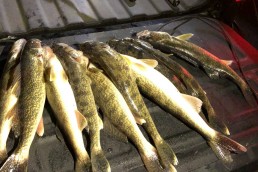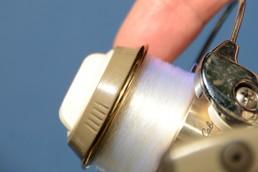John Milam, Early Reel Maker
SHARE THIS POST
Fishing history of early fishing reel creators
We are fortunate that outdoor sports writers produced many articles on early fishing tackle makers. Some great writers in the 1800s and early 1900s produced magazine articles and books that were informative back then and remain important and interesting today. While reviewing these old publications is great, the Internet provides more information than we could have imagined just decades ago. In 1834, a 13-year-old apprentice made a brass fishing reel in the watchmaker shop of Theodore Noel. Benjamin Cave Milam established his future as a master reel maker. He was born on July 1, 1821 and became an apprentice reel maker for J.F. Meek in 1836.
In 1851, when Milam was 30 years old, he partnered with his previous employer. Their company then became Meek & Milam until two years later, when Meek retired. Milam’s son John W. joined his father’s business and the company made reels until 1928.
Milam Reels never quit
Benjamin continued stamping his reels Meek & Milam until 1880 when his stamping became “B.C. Milam.” Writers then proclaimed them, “great in their manufacture and service.” Writers reported: “Up to this time, we have never heard of one wearing out.
“The Milam is a combined multiplying and click reel and is therefore equally available for fly or baitfishing. It multiplies four-fold. The friction of its moving parts is so slight that a single smart stroke of its handle produces about one hundred revolutions of its spool. In baitfishing, the reel is used ‘clear,’ i.e. with clicker alarm. With a little practice, the bait can be dropped with ease and precision on any spot within 50 or 60 yards. For fly-fishing, it is customary to use the drag and click whether together or singly.”
“Only the finest materials are used in these reels. Pinions and pivots are carefully tempered and accurately fitted steel. No castings are allowed to enter into the Milam. Only wrought metals are used. Caps, plates and handles are all cut from hard-rolled sheet metals.”
These reels were made from a small size 1 to a large number 8 tarpon size. What we would classify as a casting reel was also used on the underside of a fly rod for fly fishing.
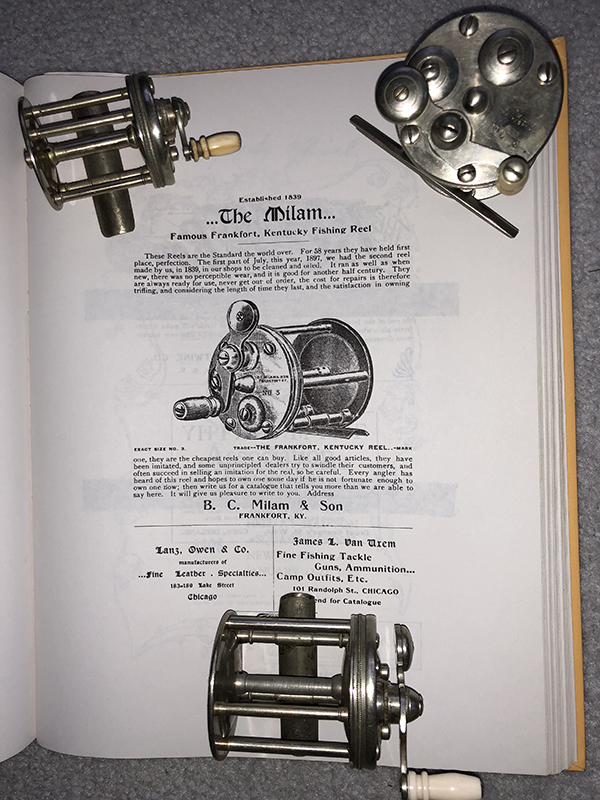
Superiority comes standard
The American Game Fishes, published in Chicago in 1891 by Rand McNally, titled “Reels, Their Uses and Abuses,” stated: “Anglers have found that a reel that is high-priced at first, proves cheapest in the end. Those made in the 1830s are good today, and have been in constant use ever since they left the shop.”
“Each part must be perfect as you go. You should get your metal rolled hard till it springs like steel. Then cut the caps and plates from this. Never should a casting be used. It is too soft and a smart fall may render your reel useless. The secret is the gearing, requiring the greatest skill in it’s construction. We expend more time and labor on our gearing alone than is used to make a complete machine reel. You are equipped for a lifetime once the gearing is done properly.”
Are you enjoying this post?
You can be among the first to get the latest info on where to go, what to use and how to use it!
Fact or fable
Such high praise for a product from any reel maker might be seen as false promotion. But, over time, the praise for Milam reels has proven to be well earned. We have several in our collection that still serve us well by wining casting tournaments and providing smooth, fast casts to this day.
Milam reels received four international first prizes and medals: World’s Fair, Chicago, Illinois, Fisheries Exposition, Bergen, Norway, World’s Exposition, Paris, France and at the St. Louis Exposition. An incredible accomplishment for any reel maker.
A reel maker that makes the real deal
These reels have stood the test of time. Some bear the scars of decades of hard use but still provide smooth operation. Many others were given great care by their proud owners. Milams are in high demand by reel collectors today.
Dan Basore is a fishing historian and steward of the history of the sport. In his efforts to preserve fishing history, Basore is always on the lookout for information about early lure makers, old lures, pre- level wind reels, manufacturer catalogs, tournament casting items and the like. If you possess information or materials that can help, please contact Dan Basore, Historical Fishing Display, at 630-393-3474 or 800-347-4525 or by email at ollures@aol.com.
Catch up on the history of MWO with our founders, Gene and Gail Laulunen.
Learn more about Milam reels.
For more fishing history, check out this article by Dan Basore on South Bend Reels!
MWO
SHARE THIS POST
Did you enjoy this post?
You can be among the first to get the latest info on where to go, what to use and how to use it!
Dan Basore
Dan Basore is a fishing historian and steward of the history of the sport. In his efforts to preserve fishing history, he is always on the lookout for information about early lure makers, old lures, pre-level wind reels, manufacturer catalogs, tournament casting items and the like. If you possess information or materials of this kind, please contact him at 630-393-3474 or by email at ollures@aol.com.
